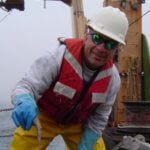In January, right after the holidays, Nancy Baron and I traveled to New Orleans to work with the leaders from the Gulf of Mexico Research Initiative (GoMRI) – a 10-year research program to investigate and understand the effect of oil spills on the environment and public health. The Gulf is the focus of a lot of investment in research these days, and these scientists are at the forefront, studying the effect of oil spills on the natural and human environment. This training brought together the Principal Investigators for the GoMRI Consortia, as well as several of the Research Board Members. These scientists are studying how oil and dispersants move in the ocean, the role of microbes in the reduction of oil, and the health of the marine and human communities around the Gulf, among other topics.
Scientists working in a post-disaster environment have unique opportunities but can also face challenges in communicating their work. Even six years after the spill, the need for this information is acute, as federal, state and local entities make plans for restoration activities, and put new oil spill response policies into place.
We talked with two of the scientists who participated in the training about their experience.

Dr. Natalia Sidorovskaia. Photo from Dr. Sidorovskaia.
Dr. Natalia Sidorovskaia is the GoMRI Director and Principal Investigator of the Littoral Acoustic Demonstration Center-Gulf Ecological Monitoring and Modeling Consortium, and is also a professor at the University of Louisiana at Lafayette, where she also serves as Chair for the Department of Physics. Natalia studies
the impact of human activities on whales and dolphins in the Gulf of Mexico, with a focus on using whales to better understand the long-term recovery of the Gulf after the 2010 oil spill.
Dr. Tracey Sutton is the GoMRI Director and Principal Investigator of the Deep Pelagic Nekton Dynamics Consortium, and is also an associate professor in the Department of Marine and Environmental Sciences at NOVA Southeastern University.

Dr. Tracey Sutton. Photo from Dr. Sutton.
His research focuses on the structure of marine communities and the processes that drive that structure, particularly in the open ocean and deep ocean midwaters.
Did the training change your approach to outreach and your research?
Natalia Sidorovskaia: I learned that it is important to deliver concise, focused messages, even if they don’t contain the whole scope of research that has been done. Always answer the question: So what? The team also gave me great suggestions for how to talk about my research in a manner that a non-scientific audience can relate to and be excited about.
For example, our research team is particularly interested in using whales as sentinels in understanding the long-term recovery of the Gulf of Mexico and coastal communities after the 2010 oil spill. Because marine mammals are at the top of the oceanic food web, their abundance trends and habitat preferences can serve as indicators of the health of the entire Gulf of Mexico ecosystem.
These animals have a life span of over 70 years, they are long-term coastal residents, they are exposed to the same contaminants as coastal communities, and they eat the same things that end up on our seafood restaurant tables. So these marine mammals are not only ecosystem dynamics sentinels, they can also be effective sentinels for public health issues.
Tracey Sutton: I was taken by how important preparation for a media/outreach presentation is in terms of delivering concise, non-garbled points that would resonate with an audience. The multiple iterations of the Message Box technique, especially while getting input from colleagues, was hugely beneficial. The role playing exercises by the ‘reporting’ staff were brilliant.
What surprised you most during the training?
Natalia: You shouldn’t rely on journalists to distill your message after an interview and make it understandable for the audience; you have to do the job yourself!
Tracey: The process behind scientific writing is much more complex than I had imagined. It is one thing for us to talk in front of a microphone—it is totally another to be the one who has to construct an interview and then relay that interview to an editor and then an audience. A higher appreciation of that will hopefully make me a better interview subject.
What aspect of the training will be most useful to you in the future?
Natalia: How to communicate my science to a general audience, including children, stakeholders, and regulators who may not be experts in the field of my research. It was a nerve-wracking experience to be on the spot, I felt like a student again, but it was well worth it.
Tracey: The premium put on the importance of our evaluation as scientists of what is truly an important point (versus what is a tangent) was the most useful aspect for me. So much of our time as a scientist is spent in a lab or in front of a computer that we often do not make the time to hone other aspects of our craft. Sharing what we do with the outside world, in a venue other than publications, really needs to be a priority.



